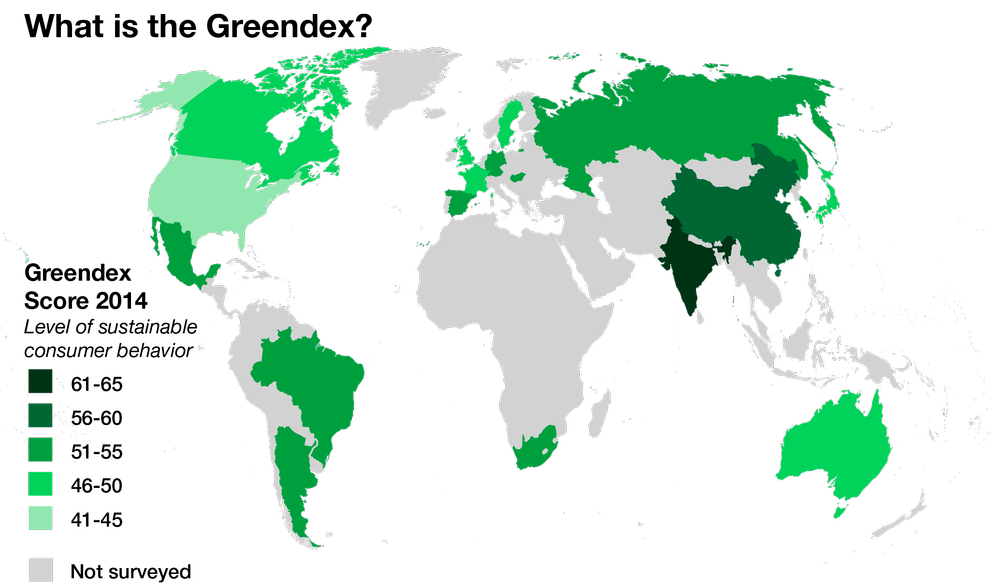More people are eating local and organic foods and plan to consume less meat and bottled water. However, most also believe they lack enough information and influence to become more environmentally sustainable consumers, a new National Geographic survey has found.

Jason Plotkin, owner of a small organic farm near Golden, Colorado, grapples with red, white, and golden beets he plans to sell at a farmers market. Photograph by Cyrus McCrimmon, Denver Post/Getty
The latest Greendex survey by the National Geographic Society and the research consulting firm GlobeScan measured consumption habits and attitudes in 18 countries. Each was scored on the relative size of its environmental footprint. (Related: 8 Surprising, Depressing, and Hopeful Findings From Global Survey of Environmental Attitudes.)
This year’s report, the fifth since 2008, focused on food. It found noticeable improvements in eating habits even as environmentally sustainable behavior when it came to housing, transportation, and consumer goods appeared stuck or had worsened.
Consumers in 11 countries, including South Korea, Hungary, Australia, and Canada, had higher food scores compared with their scores in the previous survey, in 2012. (Read “The Next Green Revolution” in National Geographic magazine.)

The Greendex is a quantitative study of 18,000 consumers in a total of 18 countries (14 in 2008, 17 in 2009 through 2012) asked about energy consumption and conservation, transportation choices, food sources, the relative use of green products versus conventional products, attitudes toward the environment and sustainability, and knowledge of environmental concerns. A group of international experts helped determine the behaviors that were most critical to investigate. NGM Staff
India, which has ranked first in food sustainability in every Greendex, came out far ahead again, thanks to its culturally dictated eating habits. Nearly one in four Indians is a vegetarian, and those who aren’t tend to avoid beef, the most environmentally damaging meat. Indians have reduced the amount of imported food they eat and increased their consumption of locally produced, homegrown, and organic foods.
Sprawling Countries Eat the Most Locally
More than half of consumers surveyed frequently eat locally grown food. Russians are the biggest locavores—77 percent consume local food daily or several times a week—followed by Indians and Chinese.
Russians, along with Hungarians, Swedes and Germans, also are eating more organic food and natural foods, now more and more part of mainstream diets.
Better informed consumers are more likely to pay attention to food ingredients, believe meat is bad for the environment, and be willing to pay more for organic and local foods.
Despite the move toward more sustainable habits, just 34 percent of consumers think they know enough about the quality, origin, and safety of the meals on their plates, and 43 percent believe they have little influence over how their food is produced. Consumers in every country are more concerned about food safety than in 2012, with the Chinese worrying the most, after a recent series of tainted-food scares in their country.
“Consumers feel somewhat alienated from the food system,” says Eric Whan of GlobeScan. “They don’t feel particularly empowered to affect how food is produced.”
Food as Culture
Majorities in every country except Sweden said that food is an essential part of their culture. Indian, Chinese, Spanish, and Mexican consumers were most attached to their national foods.
Some comfort foods, though, pose cultural barriers to more sustainable behavior.
Mexicans ranked last in the Greendex measure of food due to a diet heavy in beef and chicken. The Japanese, who eat more fish and seafood than anyone, ate the next least-green diet. Swedish and Spanish consumers saw the biggest drops in their food scores since 2012, thanks to bigger appetites for fish and seafood in both countries and for chicken in Spain.
Meanwhile America’s junk food culture means its consumers eat the most processed and packaged foods and the fewest fruits and vegetables. And not surprisingly for island nations, the British and Japanese eat far more imported food than homegrown.
When told certain foods were less harmful to the environment, consumers in every country said they planned to eat more grains and beans and to buy more locally produced or natural food. They also vowed to cut down on meat, bottled water, and packaged foods.
Yet consumers in most English-speaking countries and in Sweden were less interested in how their food was produced than people elsewhere. Globally, more consumers reject than accept the idea that eating meat is bad for the environment. Those who plan to eat less meat in the future cite health or cost more than the environment as their prime motivator.
Nicole Darnall, a researcher at the School of Sustainability at Arizona State University, is not surprised by the slow-as-molasses rate of change, especially in the United States.
“We haven’t seen broad, sweeping laws that would radically change how consumers interact with food,” she said in an interview. “We subsidize traditional food production in a way we don’t subsidize natural and organic foods.”
Not Our Problem
British, German, Australian, American, and Canadian consumers showed little interest in changing their consumption habits to diminish their environmental footprints—even though theirs were among the biggest.
The most stubborn consumers lived in Japan, which last week announced it will resume whale hunting and where nearly half eat pork several times a week.
“Something’s going on in Japan—talk about entrenched,” says Susan Frazier, research manager at NGS. “There’s not much there that’s changing for the positive.”
Despite the industrial world’s relative resistance to change, the Greendex offers reason for hope. Consumers in five countries with a total of 1.8 billion people—Mexico, Brazil, Argentina, China, and India—all have a keen appetite and a great potential for change. Many consumers in those countries, when given information about how their habits affect the environment, indicated that they were open to altering their behavior in ways that would contribute to a more sustainable planet.
“The developing world is more nimble, less entrenched than we are,” Darnall said. “It’s easier for them to consider alternatives.”




